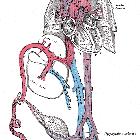umbilical cord


The umbilical cord is a fetal organ that connects the placenta to the developing fetus and is a vital passage for nutrients, oxygen and waste products to and from the fetus.
Gross anatomy
The umbilical cord inserts into the center of the placental bulk and into the fetus at the umbilicus. Variations in insertion can occur. For example, eccentric insertion, marginal insertion and velamentous insertion may be seen . It measures 55-60 cm in length with a thickness of 2.0-2.5 cm . The normal cord has two arteries and one vein :
- paired umbilical arteries (branches of the internal iliac artery) carry deoxygenated blood from the fetus to the placenta
- umbilical vein runs carry oxygenated blood from the placenta to the fetus
Related pathology
- variation in cord insertion
- variation in morphology
- umbilical cord thrombosis
- umbilical cord hematoma
- single umbilical artery
- umbilical cord cyst
- umbilical cord pseudocyst
Siehe auch:
- Omphalozele
- nuchal cord
- singuläre Nabelschnurarterie (sNSA)
- short umbilical cord
- umbilical cord prolapse
- Nabelschnurzyste
- lesser number of coils in umbilical cord
- Nabelschnur-Pseudozyste
- entangled cords
- abnormal cord insertion
- umbilical cord knots
- Thrombose der Umbilikalarterien
- two-vessel umbilical cord
und weiter:

 Assoziationen und Differentialdiagnosen zu Nabelschnur:
Assoziationen und Differentialdiagnosen zu Nabelschnur:singuläre
Nabelschnurarterie (sNSA)






